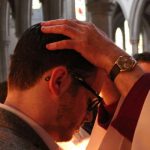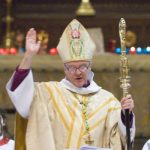Sermon preached on 4 September 2016 by the Rev PJ O’Maoil Mheana
Forum with the Canon Missioner – the Rev Audrey O’Brien Stewart
Sermon – Audrey O’Brien Stewart 28 August 2016
Sermon preached by Kelvin Holdsworth 21 August 2016
Sunday 21 August 2016
The church is open at service times and from 10am to 12.30pm daily.
0830 Said Eucharist (1970)
1030 Sung Eucharist (1982)
Presiding: The Rev Cedric Blakey
Preaching: The Very Rev Kelvin Holdsworth
1830 Choral Evensong and Installation of the Canon Missioner
The Sacraments: Unction
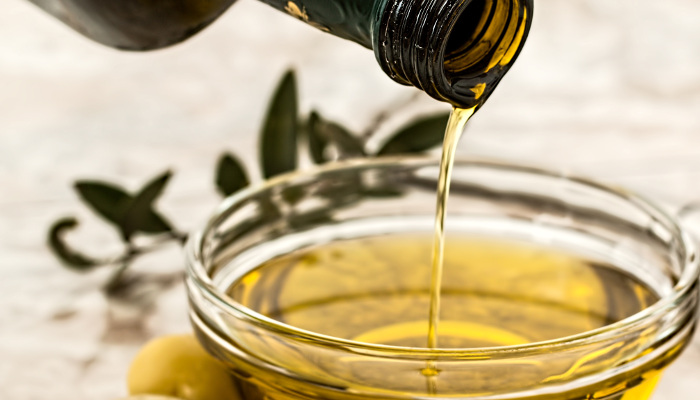
The most common way in which people think about the sacrament of Unction is thinking about what can happen at the very end of someone’s life when they are anointed with holy oil in what people call the last rites. However there’s more to this sacrament than that.
Many different religions have healing rites associated with them and Christianity is not the only one which uses oil as a symbol of healing.
Every year just before Easter, the bishop blesses oil for use in the churches of the diocese for different purposes. Three vessels of oil are blessed. One is the oil of chrism which is used to anoint people at baptism, confirmation or ordination. The second is the oil of catechumens which may be used to anoint someone as they engage on a period of study or preparation which might lead to baptism. And the third of the oils is the oil of healing which is used in the sacrament of unction. The oil that we use is ordinary olive oil. Sometimes it is oil that has been harvested from olive trees in the holy land.
The oil of healing can be used at different points in someone’s life and not just as someone is dying. Whenever it is used, it remains the oil of healing. Even if someone is being anointed at the point of death, we remember that God’s healing presence will be with them through and beyond their life on earth.
When Christians pray for healing they are doing something more than simply making wishes or casting spells. They are remembering the extraordinary fact that God has made healing a part of every person’s life on earth. That healing may not always be a cure for what ails someone but God’s presence is with them no matter what life throws at them. We know that in biblical times, gathering to pray for the sick with the laying on of hands was part of the community life of the early Christians.
We believe that healing is an aspect of the activity of God in the world and that we sometimes encounter that in the work of doctors, nurses, therapists and those who carry out research.
Sometimes people ask to be anointed with oil if they know that they are going into hospital for an operation. Sometimes the oil of healing is requested by someone as they pray for psychological peace of mind.
It remains the case that there is a particular ministry of care and compassion that the church can offer if someone knows that they are getting close to death. Part of that preparation for death might include aspects of the sacrament of reconciliation and partaking of the Eucharist, as well as anointing with oil.
Christians believe that death is not the end of someone’s life with God. The new life that is proclaimed at Easter and throughout the year in church is something that all those who die will encounter. Inevitably there are many aspects of this that we don’t understand fully whilst here on earth. However, we believe that when someone dies they come to know the full reality of God’s love. At a funeral in church the Pascal Candle – the great symbol of the Easter resurrection news is lit.
Frequently Asked Questions
If someone doesn’t get to receive the last rites do they still get to heaven?
Yes – God is not bound by the sacraments. The physical symbols that are used such as anointing with oil are merely outward signs of the activity of God which is unlimited. In any case, we believe in a God of love who saves and does not condemn.
The Sacraments: Confirmation
Confirmation is something that has changed in recent years significantly. At one time everyone knew what confirmation was. It was an unambiguous sacrament. It was the means by which young people at a particular age (never entirely decided upon) came into the full sacramental life of the church. By being confirmed they were confirming the vows that had been made on their behalf when they were young children and were thus deemed ready to receive communion for the first time. Although some adults were always confirmed they tended to be the exception rather than the rule.
Nowadays, confirmations still happen throughout the year in every diocese but this has become something of a pastoral sacrament and means different things to different people. It is still undoubtedly the case that some young people are confirmed as part of their journey into the communicant life of the church. However for some years now, canon law has been very clear indeed that anyone who is baptised is welcome to receive communion in all the congregations of the Scottish Episcopal Church and so the focus on being confirmed in order to be a communicant has lost its focus.
Sometimes people are confirmed as part of their journey into the Scottish Episcopal Church (or indeed into the Anglicanism of which we are but a part) from a different denomination. For them it is a way of recognising that they have found a place within this tradition and confirmation is a sacramental way of speaking of the deep reality of finding themselves at home.
The number of adults in society who have never been either confirmed or baptised is increasing as children are no longer baptised as a matter of course. When people discover the Christian faith for the first time as adults, then baptism and confirmation (which might be administered in the same service) are a particularly joyful stepping stone on their religious journey of faith.
The different ways in which confirmation happens within our churches have led to some confusion. Some people don’t believe that confirmation still exists when that is very obviously not true. The liturgy itself has the rather complex, and some would say clumsy title: “Affirmation of Holy Baptism for Confirmation and Renewal”. Such has been the confusion about confirmation that it has sometimes slightly cynically been referred to in recent years as a sacrament in search of a theology. However, it is important to reinforce the fact that confirmations still take place and are still deeply significant life events for those who are confirmed.
Confirmation in the Episcopal/Anglican tradition is almost always something that is carried out by a bishop. People within our tradition are sometimes surprised to discover that this is not universally so amongst the Christian churches. Our friends in the Church of Sweden often experience Confirmation as something that school groups are prepared for and which is administered by the local priest. A similar pattern is also common amongst Roman Catholic congregations here in Scotland.
At its heart, confirmation is a very simple thing. It is a public declaration that one belongs to the church followed by prayers from the bishop who prays them whilst laying hands on the head of the candidate.
The prayer that the bishop prays at confirmation goes like this:
God of mercy and love,
new birth by water and the Spirit is your gift,
a gift none can take away;
grant that your servants may grow
into the fullness of the stature of Christ.
Fill them with the joy of your presence.
Increase in them the fruit of your Spirit:
the spirit of wisdom and understanding,
the spirit of love, patience and gentleness,
the spirit of wonder and true holiness.
Come, Creator Spirit,
rekindle in N. your gifts of grace,
to love and serve as a disciple of Christ. AmenRenew her/his life in Christ
and bring to completion
all that your calling has begun. Amen
Frequently Asked Questions
Do I need to be confirmed in order to receive communion?
No, no – and a thousand times no. Canon law in the Scottish Episcopal Church could not be clearer. You do not need to be confirmed in order to receive communion.
I was confirmed at a time in my life when it didn’t mean much to me – can I be confirmed again?
This is a sacrament that the church thinks of as taking place once in someone’s life – though the effects go on for a lifetime. No-one should presume that confirmation was insignificant if they are currently looking to reaffirm their faith in public once more. Should that be the case, elements of the confirmation service can be used to make a fresh affirmation of faith in public.
Do I have to be confirmed at all?
There are some roles in the church for which confirmation is required however they are diminishing. It is still the case that people need to be confirmed in order to be considered for ordination but it isn’t entirely clear why that should be the case. The requirement that General Synod Members should have been confirmed is being removed. Until very recently being confirmed was supposedly a requirement before one could be a bell-ringer at St Mary’s however this is no longer the case.
The Sacraments: Holy Orders
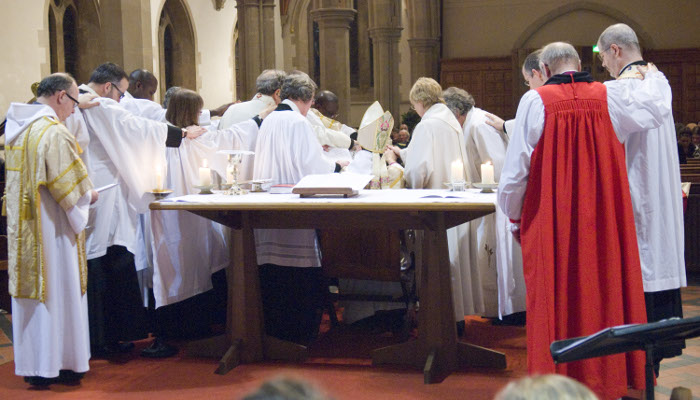
The idea of seeing Holy Orders as sacramental can seem to be a bit distant from most people who might ask whether this is just something that it is about clergy. However, to understand holy orders as sacramental means to ask what the different orders of ministry in the church represent and to remember that the charisms of each of those orders are for every Christian to exercise.
The Scottish Episcopal, in common with the ancient church recognises three sacramental orders of ministry – the diaconate (deacons), the presbyterate (priests) and the episcopate (bishops).
The foundational order of the ordained life is the diaconate. When someone is ordained as a deacon they are set aside to live a life of service both to the church and to the world. In our tradition, people are ordained to the other orders only after serving some time as a deacon and remain in deacons orders when becoming a priest or for some eventually a bishop. To become a deacon is to hear the call of God to service, to respond positively to that call and have that call affirmed by the church. When someone becomes a deacon they are regarded as a member of the clergy and bear the title “The Rev” before their name. Sometimes people mistakenly think that being a deacon is merely a stepping stone to priesthood and to be regarded as an apprenticeship. You sometimes hear people speaking of deacons as being ordained people who can’t celebrate the Eucharist or bless people yet. However, that is to misunderstand the diaconate. The point about being a deacon is to celebrate the joy of serving others. It isn’t about being prevented from doing something – rather it is about being set free in order to do something.
The Ordinal is the liturgical book which contains the ordination services. It describes deacons like this:
Deacons share with the bishop and presbyters in the ministry of word and sacrament and in works of love.
In a distinctive way deacons are a sign of that humility which marks all service offered in the name of Christ. They bear witness to the Lord who laid aside all claims of dignity, assumed the nature of a slave and accepted death on a cross.
In the name of the Church, deacons care for those in need, serving God and the world after the pattern of Christ.
Most members of the clergy are priests. Those in this ministry have a calling to bring God to people and to bring people to God. They are set apart to live a life in which prayer is central and are entrusted with the care of the people of God. Ordination services of priests are always joyful occasions and involve a number of ceremonial elements which speak of the deeper truth of the life that a priest will live out. A chalice and paten (the cup and plate of the communion service) are placed into the hands of the new priest in recognition that it is priests who celebrate communion services as part of their life of drawing people deeper into relationship with God. Another distinctive feature of a priesting service is the laying on of hands – all the priests present will lay hands on the new priest as the Holy Spirit is invoked. This reminds everyone that priesthood is a corporate ministry which stretches back to the time of the apostles. A part of that ministry is to proclaim God’s forgiveness in the world and priests have a particular role in hearing people’s confessions and proclaiming that they are forgiven.
The ordinal describes priesthood like this:
The ministerial priesthood and the priesthood of all believers are related. Each in its proper way partakes of the one priesthood of Christ.
Presbyters (ie priests) share in the priestly ministry of their bishop. With their fellow presbyters they serve and sustain the community of the faithful that we may grow into the fullness of Christ and be a living sacrifice acceptable to God.
Presbyters pray and care for those committed to their charge, enabling them to respond freely to God’s call.
They proclaim the coming of the Kingdom, calling sinners to repentance and absolving them in God’s name.
They preside at the Eucharist and draw together in worship those who come to the Lord’s Table, so that fed by the Body and Blood of Christ they may go out to serve God in the unity of the Spirit.
In all organisations, someone needs to lead and the order of ministry which specifically recognises the sacramental gift of leadership is the episcopate. When someone becomes a bishop they become the spiritual leader for a diocese. A cathedral has a special role in being the seat of the bishop. Indeed, the seat of the bishop which is called a cathedra is what gives a cathedral its name. One of the features of a service where a bishop is consecrated is that they are seated in their own cathedra. Bishops have other symbols attached to their ministry. They wear a prominent cross, wear a ring on the fourth finger of their right hand and carry a pastoral staff in their left hand. This staff is called a crozier and in the western church looks exactly like a shepherd’s crook. This is indicative of a pastoral ministry. Bishops in the Scottish Episcopal Church have considerable authority but that is not the same thing as having absolute power. In recent years bishops have seen themselves as being leaders in mission in their diocese.
The ordinal again offers a clear description of what bishops do:
Bishops follow in the succession of the apostles whom Christ sent to proclaim the Gospel to the world and to bear authority in the community of faith. With their fellow bishops they oversee and care for the universal Church. As people under authority they must be attentive to the Holy Spirit who leads us into all the truth; called into the fellowship of Christ’s disciples, they must seek God’s will.
Within the diocese the bishop ordains and sends out new ministers, guides and serves the priests and deacons who share in the bishop’s responsibility to nurture the community of the baptised.
There is one Lord, by whose authority bishops teach and enable others to bear witness, so that God’s Word may enlighten the people of God and heal the nations.
There is one Shepherd, at whose call bishops seek to know his flock and be known by them.
There is one great High Priest of the new covenant, in whose name bishops preside over the church’s offering and call all to be of one mind and purpose, that in unity they may present to God a single, holy, living sacrifice.
The ministries of deacon, priest and bishop are symbolic of the ministry of the whole people of God and every Christian has a stake in what the orders do. Those who are ordained have a public responsibility to live out, and be seen to live out, the gifts of the order(s) to which they have been called by the people of God. However, every member of the people of God has a responsibility to commit acts of loving service, to reconcile people to the God who loves them and to take responsibility for exercising loving judgement and decision making wherever they go. In this way, the sacrament of holy orders belongs to every member of the church not merely to those who have been set aside in this way.
Frequently Asked Questions
Are priests the equivalent of “ministers of word and sacrament” in other traditions.
Priests do many of the things that those called ministers do but not all traditions will see ministry as being sacramental. All three orders of ministry in the Scottish Episcopal Church are seen as being orders of word and sacrament.
Can bishops move other clergy around as they chose?
No – this is a myth. Bishops cannot simply move people as they choose. In almost all cases in the Scottish Episcopal Church the representatives of a local congregation have a paramount role in deciding who their priest will be.
The Sacraments: Marriage
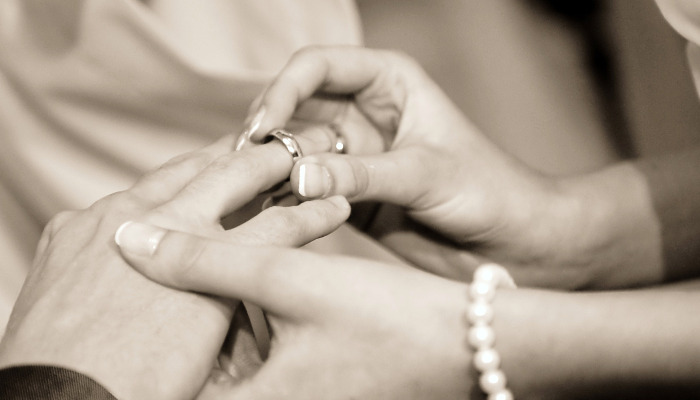
The sacrament of marriage is one of the most contested, commented on and discussed elements of church life. At its heart is that two people pledge to love one another exclusively until they die. Controversies surround which people should be able to do this to one another and what the limits of the sacrament are if the covenant between the two people becomes broken but it is important not to lose sight of the idea that the committed love between two people is seen by the church as speaking not only of the couple themselves but of God’s love for the world.
Marriage is not only regarded as something that is sacramental. Nowadays it is also a very clearly defined legal status which is regulated by civil authority. The civil regulation surrounding marriage has increased and changed over the years. At this point in history, people are only regarded as legally married if they have gone through a legal ceremony which can take place either in front of a registrar or in front of a religious celebrant. At one time in Scotland a couple (made up of a man and a woman) could claim to be legally married if they could prove that they were generally regarded as being a married couple by society. The days of so-called “habit and repute” marriages are now over and anyone wanting to marry must do so formally.
Marriage is unusual amongst the sacraments in being one in which the priest who presides over the marriage is not in fact the minister of the sacrament. Instead, the couple themselves are regarded as the celebrants of the sacrament one to another, the priest being merely the one responsible for ensuring that everything is in order and acting as the chief amongst those witnessing the event. A cleric marrying two people has the joy of declaring to the assembled company that the couple are in fact married. Sometimes the sacramental nature of this is acted out by binding the couple’s hands together using the stole, the scarf like garment that a priest wears.
Other outward signs and symbols of what is happening include the exchange of promises, the vow made between the two people and the exchange of rings which might be blessed by the priest.
The current controversies over marriage are mostly about whether or not same-sex couples should be able to get married in church. In Scotland a same-sex couple can currently marry in the eyes of the law but not in a Scottish Episcopal Church. This matter will come before the General Synod in June 2017 and it is possible that the situation may change then.
However, it should not be presumed that issues surrounding same-sex couples are the only way in which marriage has changed. Perhaps more fundamental is the way that the marriage service now presumes the couple coming to be married to be equals. At one time the marriage service effectively saw what was going on as a transaction in which the woman was handed over from her father to her new husband rather like a piece of property. This can still be seen in the way that some people chose to enter a church for a marriage, the woman coming down the aisle on her father’s arm. Such things are not part of the rites of the church and there are other ways of entering which some couples chose. For example, some couples who are already living together may prefer to come down the aisle with one another and together with any children that they might have. The equality of the two people getting married is a distinctive feature of the modern marriage service which the church uses. Another feature of this service is that the couple themselves get to choose many of the things which happen, carefully constructing a service which represents who they are. There are no “off the shelf” marriage services in the Scottish Episcopal Church.
Marriage ceremonies can be very simple or very spectacular. They are always moving occasions because people bring their greatest aspirations together and hope not only for the best for one another but declare that they will offer the best of themselves to the other partner.
Marriages are regarded as sacramental because the outward signs of living together in a loving exclusive partnership speak of the love that God has for us. This isn’t a new idea, it is one that has been around since biblical times. It is important to remember that it is marriage which is thought of as a sacrament, not a wedding service. Weddings are wonderful but the thing which reminds us of God is passionate, self-giving, committed, exclusive, joyful love.
Frequently Asked Questions
Are you more married if you get married in Church than in a Registry Office?
No
I’ve been married before, can I still get married in Church?
The Scottish Episcopal Church marries a lot of people who are doing this for the second time around. The clergy can agree to marry people in that situation with their bishop’s permission. The important thing to do is to talk to one of the clergy about this. Clergy at St Mary’s will not agree to perform a marriage or bless a civil partnership if doing so would lead to a scandal – for example, if you have children from a previous relationship whom you are not supporting financially.


